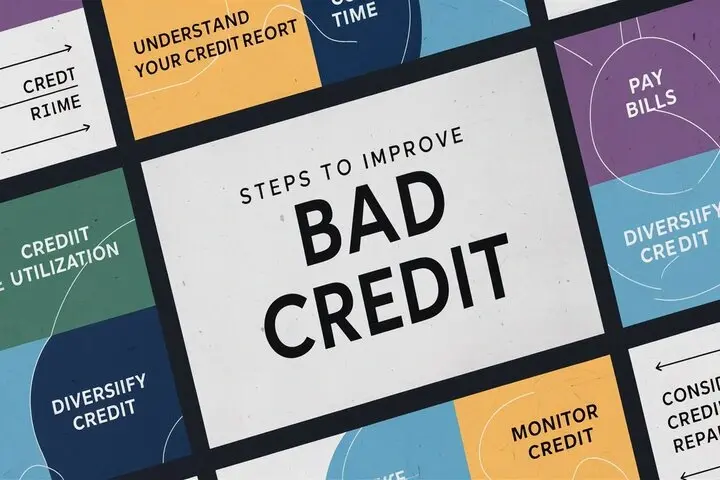
By having a low credit rating, your chances of being approved for loans, credit cards, mortgages, rentals, and even employment opportunities are limited. Luckily, although you cannot delete your bad credit history in a single day, you can make efforts to clean your credit history and get your score improved in the long run. Here are 8 essential strategies:
Here are 8 essential strategies:
1. Check Your Credit Report
The first procedure in repairing credit is to obtain credit reports from the three major credit reporting agencies including; Experian, Equifax, and TransUnion. Ensure that you do not have bad credit activity pulling down your credit score in the process. If you have found any problems, it is vital to protest them on the spot. This, in turn, can help in increasing your score within a span of two to three months.
You can obtain one free copy of your report every year on the website: www.AnnualCreditReport.com. This way you can address developing problems before they escalate through receiving your reports regularly.
2. Pay Down Balances
Maxing out credit cards or having high outstanding balances compared to your credit limits is one of how you can significantly reduce your credit score. For the above reason, to get a better score you have to reduce or even eliminate your balances. Some people may find that they need to keep the balance of every card of less than ten percent of the credit limit to see great improvement in their score.
To achieve the most favorable outcomes, it is ideal to keep the reported balances on a credit card at zero whenever possible. Although you timely and fully pay all your bills, credit reports contain the recorded balance and reflect your credit utilization ratio.
3. Negotiate with Creditors
Call your creditors and discuss the possibility of changing your rates, improving your interest rate, no charges, and lower minimum payment and partial debt relief. If they agree to those adjustments, try to gain more information in writing. More to that, as you continue to service the balance with fresh terms and conditions, your creditworthiness is enhanced over time.
You can also explore charitable organizations that offer free credit counseling which involves coming up with a plan to approach the creditors discuss the issue and figure out how to pay them more reasonably. This will not wipe out negative entries from your reports but as accounts are paid, your credit scores should rise.
4. This means that one should not close his/her old accounts that carry a good credit rating, since this is likely to affect the credit rating negatively.
Some actively may think about canceling their unused credit cards, particularly those that come with the annual fees. But it is also important to note that doing so can reduce your score. That is why it is stated that closing accounts – especially the ones that you have held for quite some time – is a way of reducing your total available credit.
Leave it active even if you rarely use it because, in most cases, you should not see your fees go up to the credit limits. According to credit card reviews, one should make a small purchase every 6-12 months to prevent his account from being closed due to inactivity on the issuer’s part.
5. Get approval for a secured credit card
Unlike a standard credit card, secured credit cards have to be backed by a refundable cash deposit initial deposit. They help minimize credit risk to the lenders while giving you a chance to establish or reconstruct credit. After one year or more of using the secured card and paying the dues on time, this may be followed by issuance of an unsecured card and refund of the deposit.
Do not spend the secured limit even if it increases from time to time, this is a very important thing to remember. It also shows that any amount that is above the limit is considered detrimental to scoring regardless of the proportion. Avoid making transactions above 30% of the total limit, but maintain the fixed payment system.
6. Become an Authorized User
Get a trusted friend or relative with a good credit score to permit you to use any of his or her old credit cards. Refrain from using someone else’s bad credit history for credit references.
One key aspect of being an authorized user is that the credit activity of the primary account holder is reported to your credit reports. You get a positive credit history and long-standing account to which people have been paying their debts without you taking responsibility for it.
7 and 8. New issues that may arise in the process should be addressed as soon as the previous annual progress is made.
Twice a year, review the documents containing copies of your credit reports, at least once per year. Challenge within the shortest duration any adverse information that you feel is either false or fabricated to pull down your score.
If efficient negative marks do indeed linger from past problems, their scoring decline with time. About 7 years later, most of the negative items are removed from your credit reports entirely. Building a better financial behavior persists to mitigate other effects while actively working to establish a fresh credit record.
Adhering to these strategies can prove to be quite challenging, yet, with time, your credit score can fully recuperate. In the next few years or so, one can wash their slate clean from such misdeeds – with a credit score to boast of!
Call now for expert credit repair services: (888) 803-7889
Read More:
How much does it cost to fix your credit?
How do I get late payments removed from my credit report?
What is a 609 letter to remove late payments?
How rare is an 800-credit score?




